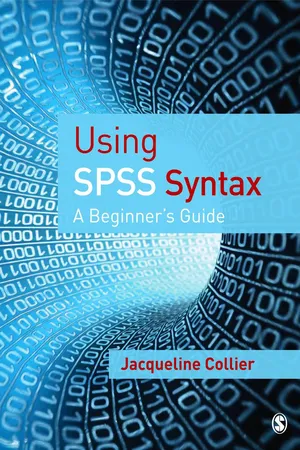
- 216 pages
- English
- ePUB (mobile friendly)
- Available on iOS & Android
About this book
Without requiring any knowledge of programming, the text outlines:
- how to become familiar with the syntax commands;
- how to create and manage the SPSS journal and syntax files;
- and how to use them throughout the data entry, management and analysis process.
Collier covers all aspects of data management from data entry through to data analysis, including managing the errors and the error messages created by SPSS. Syntax commands are clearly explained and the value of syntax is demonstrated through examples.
This book also supports the use of SPSS syntax alongside the usual button and menu-driven graphical interface (GIF) using the two methods together, in a complementary way. The book is written in such a way as to enable you to pick and choose how much you rely on one method over the other, encouraging you to use them side-by-side, with a gradual increase in use of syntax as your knowledge, skills and confidence develop.
This book is ideal for all those carrying out quantitative research in the health and social sciences who can benefit from SPSS syntax?s capacity to save time, reduce errors and allow a data audit trail.
Frequently asked questions
- Essential is ideal for learners and professionals who enjoy exploring a wide range of subjects. Access the Essential Library with 800,000+ trusted titles and best-sellers across business, personal growth, and the humanities. Includes unlimited reading time and Standard Read Aloud voice.
- Complete: Perfect for advanced learners and researchers needing full, unrestricted access. Unlock 1.4M+ books across hundreds of subjects, including academic and specialized titles. The Complete Plan also includes advanced features like Premium Read Aloud and Research Assistant.
Please note we cannot support devices running on iOS 13 and Android 7 or earlier. Learn more about using the app.
Information
Table of contents
- Cover Page
- Title Page
- Copyright
- Contents
- List of Syntax Command Examples
- Preface
- Acknowledgments
- 1. Introduction
- SPSS Conventions
- 2. Syntax for Data Entry
- Resources
- 3. Increasing the Usability of the Datafile
- 4. Amending the Datafile
- 5. Syntax Involving String Variables
- 6. Syntax Involving Date and Time Variables
- 7. Syntax for Manipulating Numeric Variables
- 8. Syntax for Data Exploration
- 9. Syntax to Enable the Use of Only Sub-sections of the Data
- 10. Syntax for Graphs
- 11. Syntax for Univariate Analysis
- 12. Syntax for Linear and Logistic Regression Analysis
- 13. Understanding Error Messages and Warnings
- Glossary
- References
- Index
- Index of Commands and Keywords